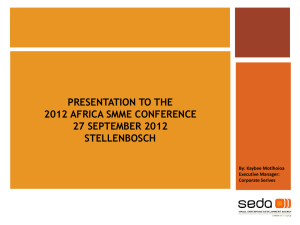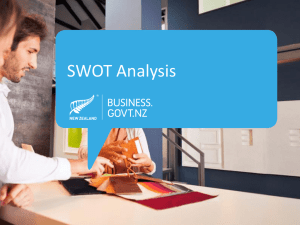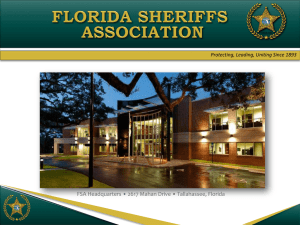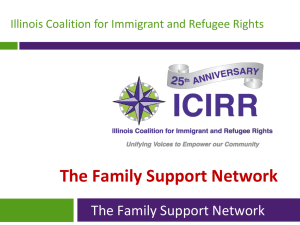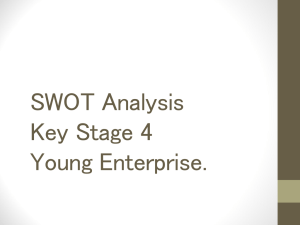Building an Organization & Defining Your Organization
advertisement
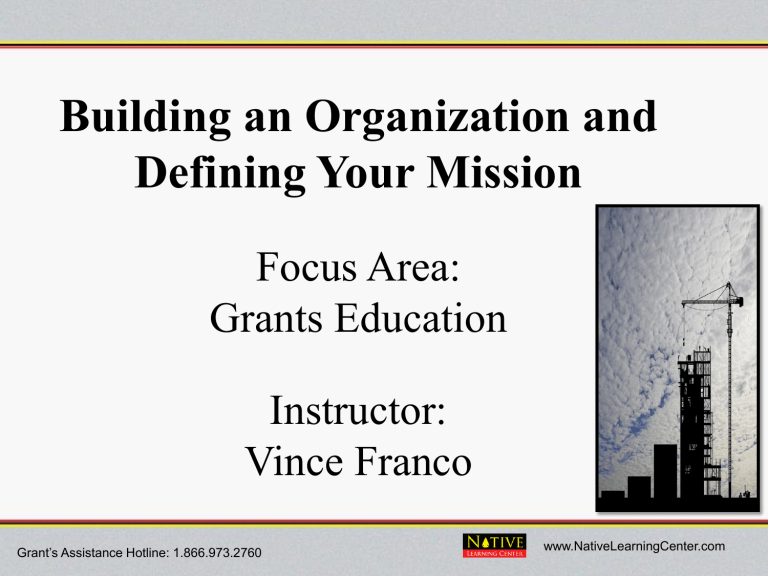
Building an Organization and Defining Your Mission Focus Area: Grants Education Instructor: Vince Franco Grant’s Assistance Hotline: 1.866.973.2760 www.NativeLearningCenter.com Course Description & Objectives Course Descriptions: Strategic thinking and an honest analysis are essential to building a strong organization that will last. This course will guide attendees through best practices in forming an organization that has a clear vision, goals, and plan. Building an Organization and Course Objectives: Defining Your Mission #1 After this course, attendees will be able to: Conduct a needs assessment; Utilize a SWOT analysis to uncover strengths, weaknesses, opportunities, and threats; Develop a mission and vision statement; Create a logic model with resources, activities, outcomes and results; Develop goals and a strategic plan; and Develop partnerships. Grant’s Assistance Hotline: 1.866.973.2760 www.NativeLearningCenter.com Your Presenter NLC Vince Franco Grants Compliance Manager Native Learning Center (NLC) 6363 Taft Street Hollywood, Florida 33024 VincentFranco@semtribe.com 1-954-985-2300 Ext. 10651 Grant’s Assistance Hotline: 1.866.973.2760 www.NativeLearningCenter.com Any Questions? • If you have a question please use the hand tool to raise your hand and type your question into the chat box (next slide). • The presenter will work to answer your questions as quickly as possible. Questions will be answered in the order they were received. • Please remember to complete the class survey at the end of this course. Grant’s Assistance Hotline: 1.866.973.2760 www.NativeLearningCenter.com How to ask a question? Grant’s Assistance Hotline: 1.866.973.2760 www.NativeLearningCenter.com Technical Issues? Unable to hear us? Grant’s Assistance Hotline: 1.866.973.2760 www.NativeLearningCenter.com What are the important aspects of a successful organization? A comprehensive Needs Assessment, a clear Mission and Vision Statement, and good Goals and/or Strategic Plan are the foundation for long-term success. Let’s take a closer look at each aspect. Grant’s Assistance Hotline: 1.866.973.2760 www.NativeLearningCenter.com Conduct a Needs Assessment Grant’s Assistance Hotline: 1.866.973.2760 www.NativeLearningCenter.com Conduct a Needs Assessment An excellent processes for any organization is conducting a survey of your potential customers, and/or other research before you launch a product or service. Consider conducting a Needs Assessment to determine if there is really a calling in your community for the services you propose to offer. Conduct a survey of a sample group to find out what they are thinking. You may assume they need one thing but they may need and/or want something else. Keep in mind that some public resources or records might already be available. Check with the Chamber of Commerce or Visitors Bureau. Grant’s Assistance Hotline: 1.866.973.2760 www.NativeLearningCenter.com Conduct a Needs Assessment The first question you should ask or at least consider: is there another organization that is providing or may provide the same program or service you are considering? Also consider: • Who is your audience? • What is their demographic profile? (male or female) Are they senior citizens, youth, single mothers? • What resources (transportation, childcare, etc.) do they lack? • Where do they live and how do they get around? • How many people are there who need your service? • What are this group's needs and desires? (education or healthcare) Grant’s Assistance Hotline: 1.866.973.2760 www.NativeLearningCenter.com Conduct a Needs Assessment Good. You have conducted a needs assessment or survey and determined that: • There is a demand within your community that is not being met by another organization, business, or agency. • Keep in mind that your organization is also a business. As such, it is vital to adopt business-like procedures. Grant’s Assistance Hotline: 1.866.973.2760 www.NativeLearningCenter.com Conduct a Needs Assessment This chart shows a comparison between a for-profit business and a nonprofit organization. With your needs assessment now complete, let’s look at a process that will help you develop a clear mission and vision statement. Grant’s Assistance Hotline: 1.866.973.2760 For-Profit Business Nonprofit Organization Sales/Profit Revenue President/CEO Executive Director Shareholders Board of Directors Stock/Dividend Issued NA Tax Return Tax Return Staff Staff Policies and Procedures Policies and Procedures Human Resources Human Resources Accountability Accountability NA Tax Deductible Contributions www.NativeLearningCenter.com Conduct a SWOT Analysis Grant’s Assistance Hotline: 1.866.973.2760 www.NativeLearningCenter.com Conduct a SWOT Analysis SWOT is an acronym for Strengths, Weaknesses, Opportunities and Threats. In its basic form, it is a focus group session to gather ideas. It is used to help an organization to focus on its strengths, minimize its weaknesses, address its threats, and take advantage of opportunities. It is conducted or facilitated through group discussion and brainstorming. Grant’s Assistance Hotline: 1.866.973.2760 www.NativeLearningCenter.com Conduct a SWOT Analysis • The rules of brainstorming are to generate as many responses as possible to specific questions within a limited time frame. • Don’t evaluate the idea; defer judgment. • Think out-of-the-box. • Record each idea; tagging/combining ideas is okay. Grant’s Assistance Hotline: 1.866.973.2760 www.NativeLearningCenter.com Conduct a SWOT Analysis What are the Strengths of your organization? Think internal or inside the organization. What are the Weaknesses of your organization? Also think internal or inside the organization. What Opportunities exist in your environment? Think external or outside the organization. What Threats exist in your environment? Also think external or outside the organization. Grant’s Assistance Hotline: 1.866.973.2760 www.NativeLearningCenter.com Conduct a SWOT Analysis What are our Strengths? What are our Weaknesses? What are our Opportunities? What are our Threats? Staff Expertise Staff Turnover Rapid Growth Weak Economy Morale and/or Attitude Morale and/or Attitude New Products and/or Services Political Structure and/or Elections Leadership and/or Transparency Lack of Professional Development Training and Development Perception vs. Reality Mission/Vision Fear of Change Facility Location Competition Policies/Procedures Facility Location Potential Partners Uncertainty Reputation Penalty/Restrictions Strong Economy Consumer Apathy Relationships Internal Politics Good Relationships Decreasing Funding Corporate Style Lack of Efficiency Increasing Funding Cost of Operation Grant’s Assistance Hotline: 1.866.973.2760 www.NativeLearningCenter.com Conduct a SWOT Analysis What are our Strengths? What are our Weaknesses? Grant’s Assistance Hotline: 1.866.973.2760 What are our Opportunities? What are our Threats? www.NativeLearningCenter.com Develop a Mission and Vision Statement Grant’s Assistance Hotline: 1.866.973.2760 www.NativeLearningCenter.com Develop a Mission and Vision Statement Your organization should develop a Mission Statement and a Vision Statement. Organizations that do not take the time to develop and implement these statements often fail to effectively operate. A well written mission statement explains “why” your organization exists and its overall purpose. It also states “what” your organization is doing. For example, the mission statement of Habitat for Humanity is to bring people together to build homes, communities and hope. Grant’s Assistance Hotline: 1.866.973.2760 www.NativeLearningCenter.com Develop a Mission and Vision Statement By comparison, a Vision Statement articulates the future path of your organization and the community it serves. A well written Vision Statement supports and lends credibility to the Mission Statement. The vision statement of Habitat for Humanity is for safe, decent, affordable homes for all. Grant’s Assistance Hotline: 1.866.973.2760 www.NativeLearningCenter.com Develop a Mission and Vision Statement Mission Statement of the Native Learning Center: Providing native and indigenous people with knowledge and skills that improve quality of life through housing related educational programs. Vision Statement of the Native Learning Center: The recognized educational resource for the development of cultural and quality-of-life skills for all known native and indigenous people. Grant’s Assistance Hotline: 1.866.973.2760 www.NativeLearningCenter.com Develop a Mission and Vision Statement Mission Statement of our Organization To provide…_______________________________________ _________________________________________________ Vision Statement of our Organization To be recognized as …_______________________________ _________________________________________________ Grant’s Assistance Hotline: 1.866.973.2760 www.NativeLearningCenter.com Create Realistic Goals (Develop a Logic Model) Grant’s Assistance Hotline: 1.866.973.2760 www.NativeLearningCenter.com Create Realistic Goals – Logic Model Once the mission and vision of your organization are established, the next order of business is the clarifying of goals. Goals assist an organization in defining its purpose. One way to express information and create goals is through the use of a Logic Model, which requires defining assumptions, problems or issues, and influences that will affect the process of the organization. This is an optional step, but let’ s look closer. Grant’s Assistance Hotline: 1.866.973.2760 www.NativeLearningCenter.com Create Realistic Goals – Logic Model Logic Models focus on the accurate establishment of resources, activities, outcomes, and results for an organization. Resources are people, materials, and supplies. Activities are the actions of the organization. Outcomes indicate a realistic short term accomplishment. Results indicate long term changes. Resources Activities Outcomes Results People, Materials, and Supplies Actions Short-Term Accomplishments Long-Term Changes NLC Staff Develop education & training Create 30 webinar topics Host 25 webinars NLC Trainers & Presenters Provide education & training Increase awareness for 500 individuals Enhance economic change for 420 individuals Grant’s Assistance Hotline: 1.866.973.2760 Every goal requires a resource and should generate activities. Most importantly, every goal for an organization should create measurable and realistic outcomes and results to justify its existence. The next step is to develop goals. www.NativeLearningCenter.com Create Realistic Goals – Logic Model Our Resources Our Activities Our Outcomes Our Results (People, Materials, and Supplies) (Actions) (Short-Term Accomplishments) (Long-Term Changes) Grant’s Assistance Hotline: 1.866.973.2760 www.NativeLearningCenter.com Develop a Strategic Plan Grant’s Assistance Hotline: 1.866.973.2760 www.NativeLearningCenter.com Developing a Strategic Plan Generally, when developing goals, an organization deals with at least one of three key questions: • What do we do? • For whom do we do it? • How do we excel? In many organizations, developing a strategic planning is viewed as a process for determining where an organization is going over the next year (goals), or from 3 to 5 years (strategic plan), although some extend their vision even further. Grant’s Assistance Hotline: 1.866.973.2760 www.NativeLearningCenter.com Developing a Strategic Plan NLC Strategic Plan 2012-2015 Goal 1: Maintain a Highly Skilled Organization Goal 2: Provide Premier Education Programs Goal 3: Develop Longevity through Partnerships Goal 4: Develop A Native Distance-Learning Program Grant’s Assistance Hotline: 1.866.973.2760 Developing a strategic plan is an organization’s process of defining its goals - or strategy - and making decisions on allocating its resources to pursue this strategy. In order to determine the direction of the organization, it is necessary to understand its current position and the possible avenues through which it can pursue a particular course of action. www.NativeLearningCenter.com Developing a Strategic Plan # Our Strategic Goal Our Sub-Goals Our Tasks 1 2 3 4 Grant’s Assistance Hotline: 1.866.973.2760 www.NativeLearningCenter.com Develop Partnerships Grant’s Assistance Hotline: 1.866.973.2760 www.NativeLearningCenter.com Develop Partnerships Other Organization Address City, State, Zip Dear Organization Leader: ABC is an aboriginal community with a population of approximately 1,500. We are located in Middletown. Not surprisingly, Diabetes is a concern for our community. I am writing to express our support and interest in your “Prevent Diabetes” educational programs. Unlike other programs, the concept of your program is extremely innovative and involves getting the community involved in attending workshops and making healthier food choices. Our community would like to become involved in this project by integrating a hands-on approach that encourages our citizen responsible for their health and the health of their children. Last but not least, strong partnerships are vital to almost every organization. It allows the organization to share resources and avoid a duplication of services. If you are considering such relationships, make sure to obtain a Letter of Support (LOS) from the other organization. The LOS should clearly define the purpose of each organization and their specific relationship, support or endorsement. Collaborations are extremely valuable for the pursuit of grants. Sincerely, Grant’s Assistance Hotline: 1.866.973.2760 www.NativeLearningCenter.com Closing Notes Technical Assistance Hotline 1-866-973-2760 Grant’s Assistance Hotline: 1.866.973.2760 www.NativeLearningCenter.com Thank You! Please visit our Website www.NativeLearningCenter.com Grant’s Assistance Hotline: 1.866.973.2760 www.NativeLearningCenter.com Grant’s Assistance Hotline: 1.866.973.2760 www.NativeLearningCenter.com Next Webinar! Title: Starting a Nonprofit Organization Focus Area: Grants Education Course Number: GE1102 Date: July 3, 2012 Time: 2:00-3:00pm EST Instructor: Vince Franco Registration is free! Grant’s Assistance Hotline: 1.866.973.2760 www.NativeLearningCenter.com

